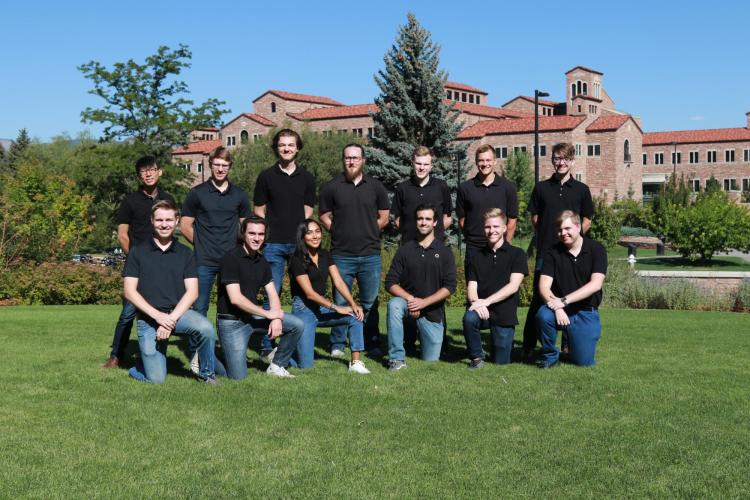CU SAE Baja takes on new four-wheel drive challenge

2019-20 CU Boulder SAE Baja team. Top from left to right: Clement Tan, Alexander Smith, Tristan Briggler, Kelton Collins, Jack Uddenberg, Alex Tilmes, Benjamin Hanpeter. Bottom from left to right: Nicholas Gunter, A. Caio Gajdys, Afnan Al-haj, Robert Giannella, Ryan Weatherbee, Jacob Hunt
Each year, CU Boulder’s Society of Automobile Engineers (SAE) Baja team competes with up to 110 different universities from across the world to engineer a single-seat, off-road vehicle, judged based on the team’s presentation of the vehicle as well as its performance in several dynamic events. This year, the CU Baja team of 13 engineers were introduced to an upcoming, unprecedented change in the competition’s requirements to take place in 2021. All vehicles will soon be required to have four-wheel drive capabilities as opposed to the current two-wheel requirement.
Since the CU Baja team hasn’t implemented four-wheel drive in the past, this year’s team decided to conquer the challenge head-on in order to offer future Baja teams design references and an opportunity to build upon a repository of previous designs.
“The initial team response to the requirement change was to take a step back and ask what the new challenge meant for us,” said Caio Gajdys, mechanical engineering senior and Baja team member.
“We understood the requirement wasn’t mandatory for this year, but it would be for the following year. We wanted to push the program to do something other teams haven’t yet. We’re in a position where we can accomplish this,” he said.
Gajdys is a part of the controls sub-team and also acts as the team logistics manager. His goal throughout the school year is to learn how to work effectively in a large team throughout a year-long, technically-challenging project.
This year’s team is motivated to contribute to the program’s growing legacy at CU. While the SAE Baja competition has been taking place for the past 43 years, CU Boulder has only been involved in the competition for five.
“I want everyone to achieve their personal goals while the team’s cumulative goals are also being met,” said Baja Project Manager Alex Tilmes. “As project manager, I have to trust that each of the sub-teams are able to come up with ideas that will last the entire endurance.” Tilmes has worked with each team to facilitate the success of the design. “My goal is to look through the designs and find any flaws while encouraging everyone to keep looking through the holes that people may poke.” With a preliminary design review around the corner, this mentality is just what the team needs to move forward.
At the competition last year, the CU Baja team was unable to complete a lap in the endurance challenge, the last event of the competition that tests how many laps the vehicle can drive in four hours. This year, the team hopes to overcome this barrier and become the first CU cohort in the past four years to complete the entire event. If successful, they would likely place within the top 30, setting a new record for CU Boulder.
This year’s competition takes place in Louisville, Kentucky, a new location for the SAE Baja competition. “We actually don’t even know what the terrain is going to look like since it’s different every year and it’s purely man-made,” Tilmes said. “Being ready for anything is going to be our key to success in completing endurance.”
To ensure success in the competition, the Baja team seeks to first build a durable, functioning vehicle. Baja is split into several sub-teams tackling front suspension, rear suspension, drivetrain, chassis and controls. Each sub-team is responsible for engineering complex designs that can interface with the functionalities of other sub-team components. They must also manage their own financing and sponsorships to buy all necessary materials and build their vehicle’s design.
“We want to present ourselves in a way that drives companies to invest in the future of students who want to go into the automotive or mechanical industry,” said Jacob Hunt, suspension sub-team member.
As a financial manager of the team, one of Hunt’s main goals is to build a lasting legacy for the program by connecting with new sponsors for the program. In order for the team to achieve this goal, they must expand their network of support.
The CU Baja team receives significant support from the faculty of Design Center Colorado as well as Director Peter Himpsel, leading them to graciously receive financial and material sponsorships from Colorado Water Jet, EMJ Metals, McGuckin Hardware, NAPA Auto Parts, Polaris, SKF and Stolle Machinery. The team hopes to continue building professional and personal relationships with those who would like to support the goals of the Baja legacy and are excited to see its growth.
If you are interested in supporting the SAE Baja program at CU, please contact Jacob Hunt about how you would like to contribute.

